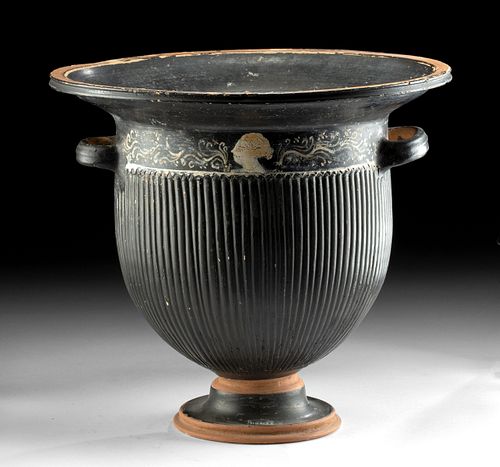Elegant Greek Gnathian Pottery Bell Krater
Lot 28d
About Seller
Artemis Fine Arts
686 S Taylor Ave, Ste 106
Louisville, CO 80027
United States
Selling antiquities, ancient and ethnographic art online since 1993, Artemis Gallery specializes in Classical Antiquities (Egyptian, Greek, Roman, Near Eastern), Asian, Pre-Columbian, African / Tribal / Oceanographic art. Our extensive inventory includes pottery, stone, metal, wood, glass and textil...Read more
Categories
Estimate:
$13,000 - $17,500
Absentee vs Live bid
Two ways to bid:
- Leave a max absentee bid and the platform will bid on your behalf up to your maximum bid during the live auction.
- Bid live during the auction and your bids will be submitted real-time to the auctioneer.
Bid Increments
| Price | Bid Increment |
|---|---|
| $0 | $25 |
| $300 | $50 |
| $1,000 | $100 |
| $2,000 | $250 |
| $5,000 | $500 |
| $10,000 | $1,000 |
| $20,000 | $2,500 |
| $50,000 | $5,000 |
| $100,000 | $10,000 |
| $200,000 | $20,000 |
About Auction
By Artemis Fine Arts
Mar 24, 2022
Set Reminder
2022-03-24 10:00:00
2022-03-24 10:00:00
America/New_York
Bidsquare
Bidsquare : Exceptional Antiquities Ethnographic Fine Art
https://www.bidsquare.com/auctions/artemis-gallery/exceptional-antiquities-ethnographic-fine-art-9057
Museum-worthy examples of classical antiquities (Egyptian, Greek, Roman, Near Eastern), Viking, Far East / Asian, Pre-Columbian, African / Tribal, Oceanic, Native American, Spanish Colonial, Fossils, Ancient Jewelry, Fine / Visual Arts, so much more! Artemis Fine Arts info@artemisgallery.com
Museum-worthy examples of classical antiquities (Egyptian, Greek, Roman, Near Eastern), Viking, Far East / Asian, Pre-Columbian, African / Tribal, Oceanic, Native American, Spanish Colonial, Fossils, Ancient Jewelry, Fine / Visual Arts, so much more! Artemis Fine Arts info@artemisgallery.com
- Lot Description
Magna Graecia, Southern Italy, Apulia, Gnathia, ca. 4th century BCE. A lovely and stately bell krater blazed with lustrous black pigment adorned with a white motif of foliage and a female portrait. A discoidal foot supports the body, the tiered stem and edge of the foot is additionally embellished by a ring of bare terracotta. The gently swelling walls are fluted and ribbed from base to below the shoulder and a pair of upturned loop handles flank the sides. The decorative bust of a lady facing left in profile is painted upon on side of the register just below the flared rim, flanked by scrolling flourishes in white. Bell kraters were originally vessels used for mixing water and wine, made for a symposium or by someone aspiring to host one. In ancient Greek society, it was crucial to mix wine with water, as drinking undiluted wine was seen as the actions of a drunkard. The krater soon became a grave offering for elite members of society, especially during the later Attic period. Size: 11.25" W x 10.25" H (28.6 cm x 26 cm)
Gnathia ware is named for the site where this type of pottery was first discovered - the Apulian site of Egnathia. The black glaze ware is traditionally decorated with floral motifs in red, white, or yellow hues. Scholars believe that its production was most likely centered around Taras, with primary workshops in Egnathia and Canosa. The quantity and quality of Greek colonial Apulian potters increased significantly following the Peloponnesian War when Attic exports dramatically decreased. Apulian artistry demonstrates influences of Ionian (Athenian, Attic) conventions, as well as Doric (western colonial Greek) styles, with a palpable native Italic aesthetic.
For a similar example, please see the University of Illinois Spurlock Museum's website, artifact number: 1922.01.0144.
Provenance: private New York, USA collection; ex-Phoenix Art Inventory, New York, USA, 1998; ex-private Mr. S.A. collection, Bloomfield Hills, Michigan, USA, acquired on the European Art Market in 1993
All items legal to buy/sell under U.S. Statute covering cultural patrimony Code 2600, CHAPTER 14, and are guaranteed to be as described or your money back.
A Certificate of Authenticity will accompany all winning bids.
PLEASE NOTE: Due to recent increases of shipments being seized by Australian & German customs (even for items with pre-UNESCO provenance), we will no longer ship most antiquities and ancient Chinese art to Australia & Germany. For categories of items that are acceptable to ship to Australia or Germany, please contact us directly or work with your local customs brokerage firm.
Display stands not described as included/custom in the item description are for photography purposes only and will not be included with the item upon shipping.
#170814Professionally repaired and restored. Overpainting to 20% of ribbed lower body surface, with infill to gaps and abraded surfaces. Restoration is well done and nearly indiscernible. Surface abrasions, nicks, and chips to rim and handles. Some fading and chipping to original painted pigments, but white motifs are still clear and discernable. Old inventory label on foot.Condition
- Shipping Info
-
All shipping is handled in-house for your convenience. Your invoice from Artemis Gallery will include shipping calculation instructions. If in doubt, please inquire BEFORE bidding for estimated shipping costs for individual items.
-
- Buyer's Premium



 EUR
EUR CAD
CAD AUD
AUD GBP
GBP MXN
MXN HKD
HKD CNY
CNY MYR
MYR SEK
SEK SGD
SGD CHF
CHF THB
THB


















